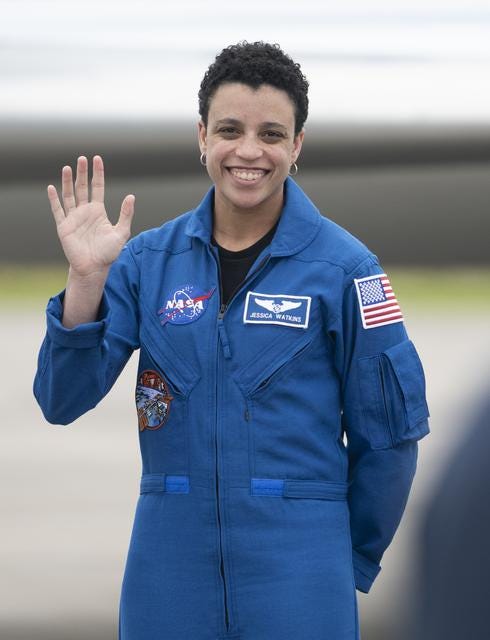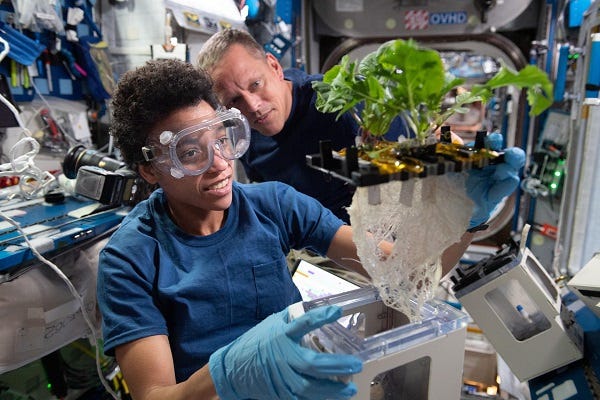
We talk about the transportation transformation here. Full Throttle posts twice a week. It's free. Please share and subscribe here.
On Friday, while you were making plans for the weekend, Jessica Watkins was getting ready for splashdown in the Atlantic Ocean off Jacksonville, Florida. Watkins was completing her first mission to space as a member of NASA’s Crew-4.
The SpaceX Dragon capsule burned through the atmosphere and deployed its four parachutes for what looked like a perfect end to the six-month stay on the International Space Station (ISS). Not a bad ending for a woman who dreamed of being an astronaut since she was eight years old.
NASA's Crew-4 aboard a SpaceX capsule returns to earth. (Credit: NASA)
Watkins was driven to become an astronaut. She began her college career studying to be a mechanical engineer. She didn’t love it. So she went back to the requirements for astronaut candidates and realized she could major in any of the various STEM fields and qualify. She chose geology.
As Jessica Watkins was becoming Dr. Watkins, she interned several times at NASA. She studied landslides, not just on Earth but on Mars as well. Watkins is a planetary geologist. She worked on the Curiosity rover that is on the surface of Mars.

NASA astronaut Jessica Watkins. Dr. Watkins is a planetary geologist. (Credit: NASA)
She and a colleague used remote sensing to write a paper on how rocks and other material on Mars ended up in a specific Martian valley. Watkins uses Earth to inform some of the science. California’s Death Valley is where she spent a lot of time for some of her research.
During her last media event on the ISS, I asked Dr. Watkins what it was like to now be above those areas she studied for her research about Mars. She told me she was now the remote sensor in space.

Watkins and crew mate Bob Hines working on a plant experiment on ISS. (Credit: NASA)
“To be able to do that kind of remote sensing observations, to be able to see Earth from essentially that kind of a planetary perspective… [after being on the ground and seeing the geology up close] and then being able to see it from a remote sensing orbital perspective and be able to marry those two has been really, really enriching and exciting for me,” Watkins told me.
Watkins is not just a scientist. She considers herself a strong team player, an ethos she learned playing rugby at the college level and then on the national team. Rugby is a tough sport that offers plenty of lessons. Her experiences may have helped lead to Watkins being named an Artemis astronaut. That group of astronauts will be considered for the missions taking the US back to the Moon.
Watkins discusses seeing geologic formations from ISS that she studied on Earth. (Credit: NASA)
The lunar surface is the next step, but Watkins has her sights set on Mars. Who better to have looking at the geology of Mars than a scientist who has studied the red planet’s surface?
When Watkins graduated from astronaut candidate school, her 2017 classmate Matthew Dominick gave the testimonial. Dominick’s background is unlike Watkins, and more like the first couple of classes of astronauts. He was a Navy test pilot and veteran of 61 combat missions.
He told those assembled for their graduation ceremony about his scientist classmate, “Would I crawl into a small spacecraft for a month with Watty? Absolutely!… She's talented. She's a natural operator. She's tough. She's not only the person you want to hang out with on a Friday night. I trust her with my life on the most daring of spaceflights.”
Watkins speaking during astronaut selection event, graduation, and as part of the Artemis program. (Credit: NASA)
Watkins focus on her goal to be an astronaut led to a 2009 Mars simulation experiment in the Utah desert. When her astronaut class was selected she heard something she was dreaming of for years. “We intend to send her to Mars one day,” said acting NASA Administrator Robert Lightfoot.
Watkins is no longer a rookie. She has been to space for the first time and, for this astronaut of the future, it's likely she will break the bounds of gravity several more times.
Please share and subscribe here.
(Cover image credit: NASA)




